Collection: Is My Lawn Unhealthy if I have Weeds and other "Unwanted" Plants?
“If I have weeds in my lawn, is it unhealthy?”
Not necessarily. Weeds are always there for a reason, even after tilling, topsoil, seed, or sod. The soil makeup and not necessarily the health, determine what plants grow in any area, including grass. You wanting green grass there and spraying for weeds will not ever make soil healthy. Read the following information to learn what different plants, or “weeds” are for and why your yard might have them. We never recommend spraying chemicals to “fix” a weed problem. We recommend mowing, aerating, dethatching, watering, plant diversity, and embracing what the earth wants growing in your yard space. Poisons are never worth the bad side effects. See our other section to read the health risks of pesticides.
This section discusses weeds of all kinds and what they mean to you, your yards, and the planet. Some info refers to farming but is still very good info.
Read Your Weeds-
Weeds can tell you a lot about the condition of your lawn and indicate what you need to
do to grow healthy grass that is naturally resistant to weeds and pest problems. Learn to
read your “weeds” for what they indicate about your lawn care practices and soil
conditions, and you’ll be on your way to creating a healthy lawn that will be less work in
the long run.
Reading weeds is actually very simple. First, know that weeds thrive in soil that is
compacted, poorly fertilized, and not pH balanced; and in lawns that are improperly
watered, seeded, and mowed.
Synthetic fertilizers and chemical pesticides also lead to undesirable conditions, which
restricts water and air movement in the soil. High nitrogen fertilizers can disrupt the
nutrient balance, accelerate turf growth, increase the need for mowing and contribute to
thatch buildup. Pesticides harm the microorganisms, beneficial insects and earthworms
that are essential to maintaining healthy soil, and therefore,
healthy turf.
Use the following chart to identify the weeds in your lawn and correct the conditions that
are promoting them with the information below. For instance, blue violets often indicate
compaction and excessive watering. Aeration and proper irrigation would correct the
conditions that are promoting blue violet growth.
While we cannot provide specific information for every region of the country, and every
weed, this general overview will highlight the association of weeds with poor soil and
management conditions. And, while we don’t focus on pests, following the
recommendations outlined here will help alleviate many pest problems.
Remember, many plants that are considered weeds, have beneficial qualities. Try to
develop a tolerance for some weeds. For instance, clover - considered a typical turf weed-
thrives in soil with low nitrogen levels, compaction issues, and drought stress. However,
clover takes free nitrogen from the atmosphere and distributes it to the grass, which helps
it grow. Clover roots are extensive and extremely drought resistant, providing significant
resources to soil organisms, and clover will stay green long after turf goes naturally
dormant. Crabgrass provides erosion control, dandelions’ deep roots return nutrients to
the surface, and plantains are edible!
Common Lawn Weeds and What Contributes To Them
Eliminate the Conditions that Promote Weeds
1. Compaction – Compaction is an invitation for weeds. If your lawn is hard, compacted,
and full of weeds, aerate to help air, water and fertilizer to enter. If you can’t stick a
screwdriver easily into your soil, it is too compacted. Get together with your neighbors
and rent an aerator. Once you have an established, healthy lawn, worms and birds
pecking at your soil will aerate it for free!
2. Mowing Height – Bad mowing practices cause many lawn problems. Mowing lower
than 1 1⁄2 to 1 3⁄4 inches can kill the root system by preventing photosynthesis, and
mowing with a dull blade makes the turf susceptible to disease. A low mowing height
also invites sunlight in for weeds to sprout.
While grass species vary across the country, most lawns are a mix of kentucky bluegrass
and fine fescue. Generally, you should keep a lawn at 3- 3 1⁄2 inches. Mowing high allows
the grass to develop deeper, drought-resistant roots systems. For the first and last cut of
the season, mow to 2 inches. Do not mow more than 1/3 of the grass blade at a time.
Keep your mower blades sharp to prevent the development and spread of fungal disease,
or ask your service provider to sharpen their blades frequently.
3. Soil pH and Soil Testing – Low pH means acidic conditions and high pH indicates
alkaline conditions. If the pH is too high, your grass cannot properly absorb nutrients.
Ideal pH should be between 6.5-7.0, slightly acidic. Generally, lime is added to raise the
pH and sulfur is added to lower the pH, and adding compost can naturally correct your
pH. A soil test is highly recommended to determine the soil pH and specific nutrient
needs. Contact your extension service to find out how to take a soil sample. In addition to
nutrients and pH analysis, ask for organic content analysis, and request organic care
recommendations. Organic content should be 5% or higher.
4. Fertility -Soil testing is the best way to determine your soil’s specific nutrient needs.
Fertilizing in early fall ensures good growth and root development for your grass.
Nitrogen, the most abundant nutrient in lawn fertilizers promotes color and growth.
Adding too much nitrogen, or quick-release synthetic fertilizers, can weaken the grass,
alter the pH, promote disease, insect, and thatch build-up.
Your grass clippings contain 58% of the nitrogen added from fertilizers, improve soil
conditions, suppress disease, and reduce thatch and crabgrass. So, leave the clippings on
your lawn. You can use a mulching mower and leave the leaves too.
Compost is an ideal soil conditioner, adding the much-needed organic content to your
soil, and suppressing many turf pathogens. In the fall and spring, preferably after
aerating, spread 1⁄4 inch layer of organic or naturally-based compost over your lawn.
Compost tea and worm castings are also great additions.
Thatch is a dense layer of grass stems and roots on the surface of the soil. Thatch is a
symptom of shallow watering and chemical fertilizer usage. When thatch layers become
1⁄2” or more, the roots will grow up within the thatch instead of in the soil, making grass
susceptible to insects, disease, and weather stress. If your lawn feels spongy, you may
have thatch buildup. Thatch is reduced by aeration, topdressing with organic matter, or
power raking. In healthy lawns, earthworms and soil microorganisms break down the
thatch.
5. Watering and Poor Drainage– Drought conditions, excessive watering or poor
drainage due to soil type are all invitations for weeds. Watering needs are very site
specific, but generally speaking, a deep watering of about one-inch once a week in the
early morning is best. Your type of soil impacts your drainage and is also site-specific.
Once you establish a deep root system from mowing high, you will need less water.
Check with your local nursery for more specific recommendations and your soil type.
6. Grass Seed and Seeding – Grass varieties differ enormously in their quality,
resistance to certain pests, tolerance to climatic conditions, growth habit and appearance.
Some weeds are the result of using poor quality grass seed. Over-seed with the proper
grass seed for your region to promote a dense turf that out-competes weeds. Consult your
extension service website to learn the best grass variety for your region and site
conditions (sun or shade). Your work to create a healthy lawn will help to protect public
health and the environment.
Source:
www.beyondpesticides.org
What's with all these weeds?
They are an indicator of your soil's health. If you have large patches of one kind of weed, your garden is trying to tell you something. Here are common weeds and what they say about your soil—plus photos. Let us know what you learn!
When weeds arrive, it's often an index of what is wrong (though sometimes what is right) with the soil. For example, weeds with deep taproots such as dandelions and burdock indicate compacted soil lacking in water, air, and nutrients.
However, weeds are also nature's way of repairing the soil for a more stable, healthy system. In the case of dandelions and burdock, their deep, strong roots also help break up that soil.
Weeds are not inherently the problem. They are a symptom, and generally a troubled system. If we learn to read the weeds as clues to our soil's condition, we can help the soil recover.
Source:
https://www.almanac.com/what-weeds-tell-you-about-your-soil
Natural Herbicide Alternatives
Deblen's lawn program lessens weeds over time without the use of herbicides. This means if you just have us take care of your lawn, we will make the grass thicker, and balance the soil so less weeds need to grow. This saves pollinators, birds, and aquatic life.
However, some people cannot wait for our program to balance things out in their yards, must have immediate results, and just obsess over seeing any weeds(you know who you are). We get it, so we have attached an article discussing non-toxic alternatives that you can apply yourself, so you don't have to use the horrible chemicals used commercially or at the store. If you must kill weeds, you should read the attached article for some ideas to avoid toxic herbicide use.
*Disclaimer* We do not endorse or apply any type of weed control. We do caution the over-use of any weed killer, even when natural, because trees share the same soil as unwanted weeds, are the biggest plants in your yard. When spraying any liquid or spreading any powder, this is taken up into all trees sharing the same soil as the unwanted weeds. Since tree roots are present out to, and even past the drip line, you can harm a tree through the roots when they drink and feed through the soil. Start with small amounts as a spot treatment and monitor how much is really needed, less is sometimes more... In addition, mulch can heat up soil and promote fungus in certain soils(less is more), and make sure you use deciduous mulch around leaf trees, coniferous mulch around pine trees so the pH is similar.
Please enjoy the following article and we hope you find some good recommendations so you can eliminate weeds without hurting our precious planet.
"Roundup Alternatives
Roundup alternatives without glyphosate are available and can be effective. Organic brand options use naturally occurring oils or acids, and some alternatives can even be made with household ingredients. Farmers may find it easier to use different herbicides or farming methods.
Interest in alternatives to Roundup has grown quickly since concerns emerged over the herbicide’s safety. Its active ingredient, glyphosate, is branded as a probable cause of cancer by the United Nation’s International Agency for Research on Cancer. But regulators in the United States have said glyphosate does not pose a risk to people’s health or the environment.
At the same time, more than 13,000 Roundup lawsuits claiming the pesticide caused non-Hodgkin lymphoma or other cancers have been filed in courts around the United States.
Everyday consumers may be in a better position than farmers to adopt alternatives to Roundup. Large farms or landscaping operations may have a harder — and more expensive — time giving up glyphosate-based herbicides.
Roundup Alternatives for Your Lawn and Garden
There are several glyphosate alternatives for controlling weeds around your house. You may need to consider different options for different parts of your yard or garden. Not all options may work in all cases.
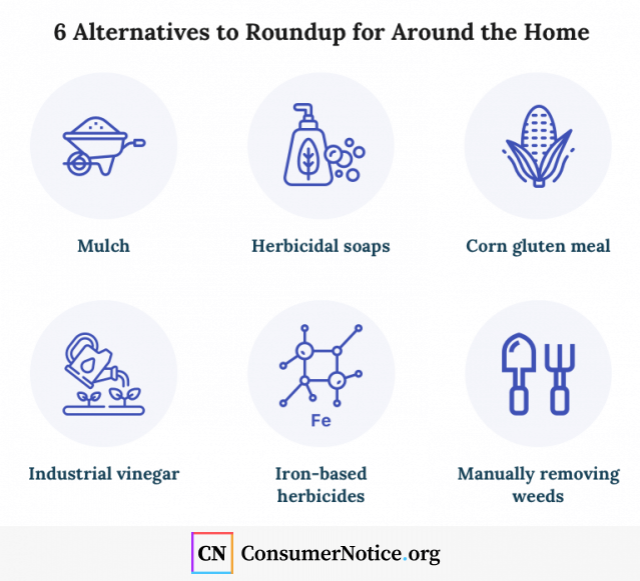
Putting down a 2- to 3-inch layer of mulch will cut off the sunlight weeds need to sprout. Any weeds that manage to germinate will suffocate under the weight of the mulch.
A handful of iron-based weed killers have been approved by the Environmental Protection Agency. Broadleaf weeds absorb iron more easily and in higher amounts than the grass in your lawn. As the iron oxidizes, it kills weeds within just hours after applying it.
Manually digging up weeds by the root may be the most effective way to get rid of them. It is also the most labor intensive.
Organic Alternatives to Roundup
Several brands of organic herbicides are available in the United States. They tend to use naturally occurring oils or acids to kill weeds. These products typically work on weeds after they’ve sprouted. However, they are not usually effective against perennial weeds.
Organic Roundup alternatives include herbicidal soaps that use fatty acids to kill weeds and industrial vinegar, which contains much higher levels of acetic acid than what you have in your kitchen. Acid-based herbicides burn down some young weeds.
Corn gluten meal can kill grass weeds and broadleaf weeds. To use it, spread 20 pounds for every 1,000 square feet of garden. Wait five days to water the area if it hasn’t rained. It should kill weeds for up to six weeks.
Organic herbicides are most effective when weeds are still small and less effective as weeds get older, according to a study by the University of California Division of Agriculture and Natural Resources.
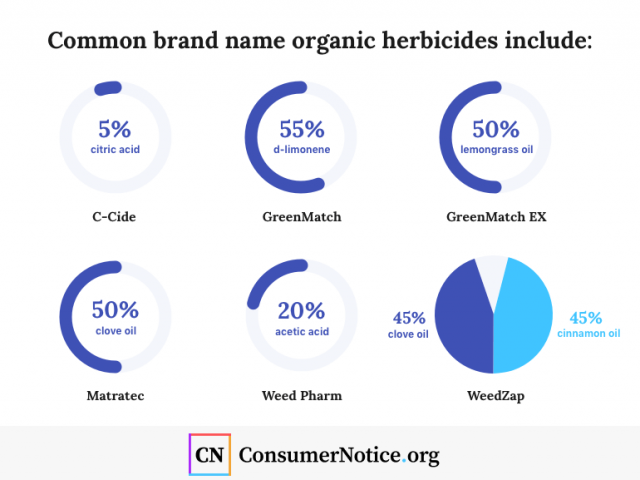
The study found that the organic weed killers were 60 percent to 100 percent effective if used in high volume against certain weeds before they were 12 days old. But they were less than 40 percent effective if used on broadleaf weeds after 26 days.
They were also expensive for large scale use, costing $400 to $600 an acre in 2010, which was more costly than pulling weeds by hand.
Home Recipe for a Roundup Alternative
If you’re worried about Roundup and cancer risks, you can cook up an alternative using easy-to-find household ingredients. The internet is full of formulas you can make at home, but you should be careful. Even seemingly safer or organic mixtures can kill plants you want to protect, damage your soil or cause you harm.
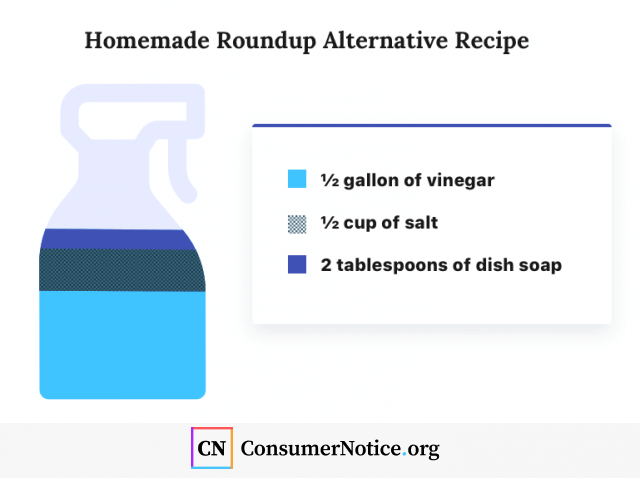
Researchers at North Dakota State University tested a popular vinegar, salt and soap homemade herbicide formula in 2014. They found it was effective at killing small annual weeds. It didn’t work very well on large annual weeds or perennials. Annuals are plants that only live a year. Perennials are those that live two years or more, coming back each year.
The researchers found glyphosate was cheaper, but the homemade mix, using store brand ingredients, was still less than $3 a gallon. That made it practical for home use against certain weeds.
The mixture can still be toxic to humans and animals if swallowed. Based on animal tests, the researchers estimated that a gallon of the salt and vinegar concoction was nearly 10 times more toxic than the store brand glyphosate they tested it against. So it should be stored away from children and pets.
So the vinegar you are using to spray your weeds is probably made from corn that was sprayed with glyphosate: the very herbicide you were trying to avoid.
You should also be aware that vinegar may contain glyphosate. That’s because most vinegar is made with corn and most corn in the United States is grown from Roundup Ready seed. Those are crops genetically modified so farmers can continue using Roundup as the crop matures.
“So the vinegar you are using to spray your weeds is probably made from corn that was sprayed with glyphosate: the very herbicide you were trying to avoid,” the researchers wrote.
You might get around this problem by using certified organic vinegar.
Farming Techniques, Other Herbicides and Robots as Alternatives
Long before people started worrying about potential health risks with glyphosate, farmers were already looking for Roundup alternatives.
The first Roundup-resistant weeds cropped up in a Delaware soybean field in 2000 and have been a growing problem ever since. By 2014, at least 24 species of weeds had developed a resistance to glyphosate.
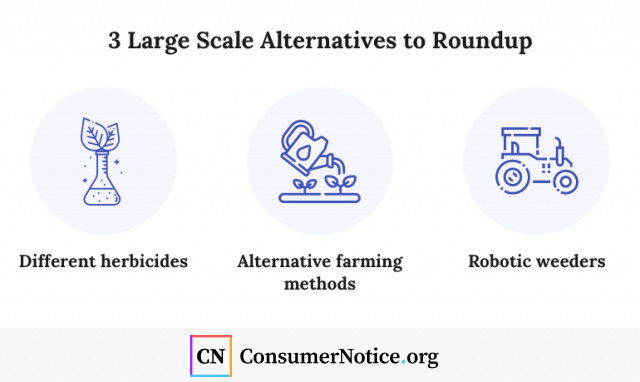
Other Herbicides
A study in 2008 in the journal Pest Management Science called glyphosate “a once-in-a-century herbicide.” Despite the rise of Roundup resistant weeds, it’s been difficult for researchers to find anything that works as well as glyphosate at controlling weeds.
But Bayer AG, the drug and chemical giant that makes Roundup, promised in June 2019 to spend $5.6 billion over the next 10 years on herbicide research.
One alternative may be biopesticides, a staple of organic farming. They’re made of naturally occurring substances found in plants, animals, minerals, fungi and bacteria. The Environmental Protection Agency reported more than 18 million acres were being treated with biopesticides in 2015.
Some farmers have switched to an older pesticide called dicamba. It can be sprayed on crops that have been genetically modified to be resistant to it while killing the weeds around them. But it’s been blamed for drifting and destroying 3.6 million acres of unprotected crops in 2017 alone.
Alternative Farming Techniques
Crop rotation — changing the crops grown in a field from season-to-season or year-to-year — can break up weeds’ growth and reproductive cycles. Growing cover crops that protect and enrich the soil during the rotation also helps.
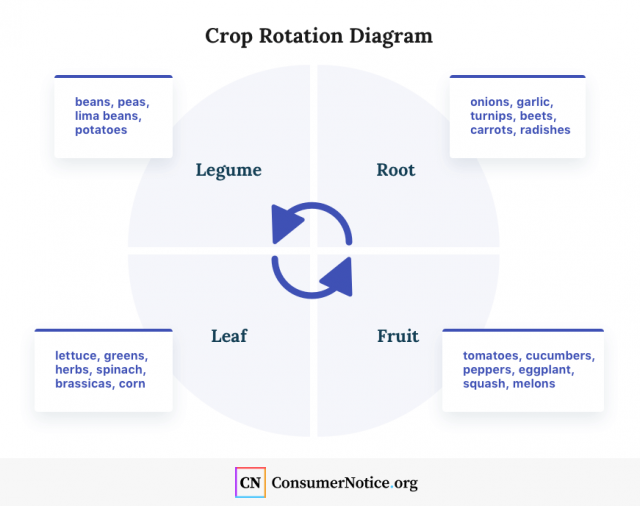
Physical weed control uses brute force against weeds. Mechanical weeders pulled behind tractors can rip weeds out between rows. Thermal weeding uses flames, steam or hot water sprayed onto weeds to kill them with heat.
Robotic Weeding
New agriculture robots may soon take over mechanical weeding chores or reduce the amount of pesticides sprayed on crops.
French company Naio Technologies has been testing its Dino weeding robot in the Unites States. Its operator types in instructions, such as field and crop row dimensions, on the four-wheeled robot’s controls. It then uses GPS and cameras to move through the field using cultivator blades to rip up weeds.
The company says the electric robot can cover 12 acres in eight hours on its own. And it could potentially cut labor costs. The New Food Economy, a nonprofit news organization, quoted a farm production engineer as saying one person could manage a fleet of 10 such robots, eliminating the need for 10 people to man a tractor each.
We see these herbicides eventually being used commercially with camera-based precision applicators that ‘see’ weeds and deliver herbicides only to the weeds, not to the crop or bare ground.
Coupling robots with organic herbicides could be an economically and environmentally friendly combination.
“We see these herbicides eventually being used commercially with camera-based precision applicators that ‘see’ weeds and deliver herbicides only to the weeds, not to the crop or bare ground,” W. Thomas Lanini of the University of California wrote in a report on research into organic herbicides.
The solar-powered ecoRobotix does just that using artificial intelligence and cameras to navigate and to identify weeds as it passes over. Two robotic arms spray pesticide precisely on weeds. And it uses 20 times less herbicide than conventional sprayers.
Why Is Roundup Still So Widely Used?
Roundup became the first glyphosate-based herbicide when it hit the market in the 1970s. Today, glyphosate is the most widely used weed killer in the world. Much of its appeal is that it is cheap and effective, according to researchers at North Carolina State University.
In a 2018 Extension Service publication, weed scientists Joel Neal and Andrew Senesac wrote that glyphosate has several advantages over other weed-killing options. It kills a wide variety of weeds, doesn’t get into the soil and kill other plants, and it’s less expensive than other herbicides.
In general, the results suggested that, compared to conventional herbicides, the alternative methods chosen for research were less effective and more costly,” researchers wrote in their report.
The scientists said there are effective alternatives to glyphosate, but each tends to have a drawback. They wrote that alternatives “will be, in some way, less effective, less convenient, and/or more expensive.”
State transportation departments have looked at alternatives for controlling weeds along thousands of miles of highway right of way. A 2008 report for Massachusetts’ transportation department found the same problems the North Carolina State researchers found.
“In general, the results suggested that, compared to conventional herbicides, the alternative methods chosen for research were less effective and more costly,” researchers wrote in their report.

https://www.consumernotice.org/environmental/pesticides/roundup/alternatives/
No products found
Use fewer filters or remove all
Subscribe to our emails
Subscribe to our mailing list for insider news, product launches, and more.
